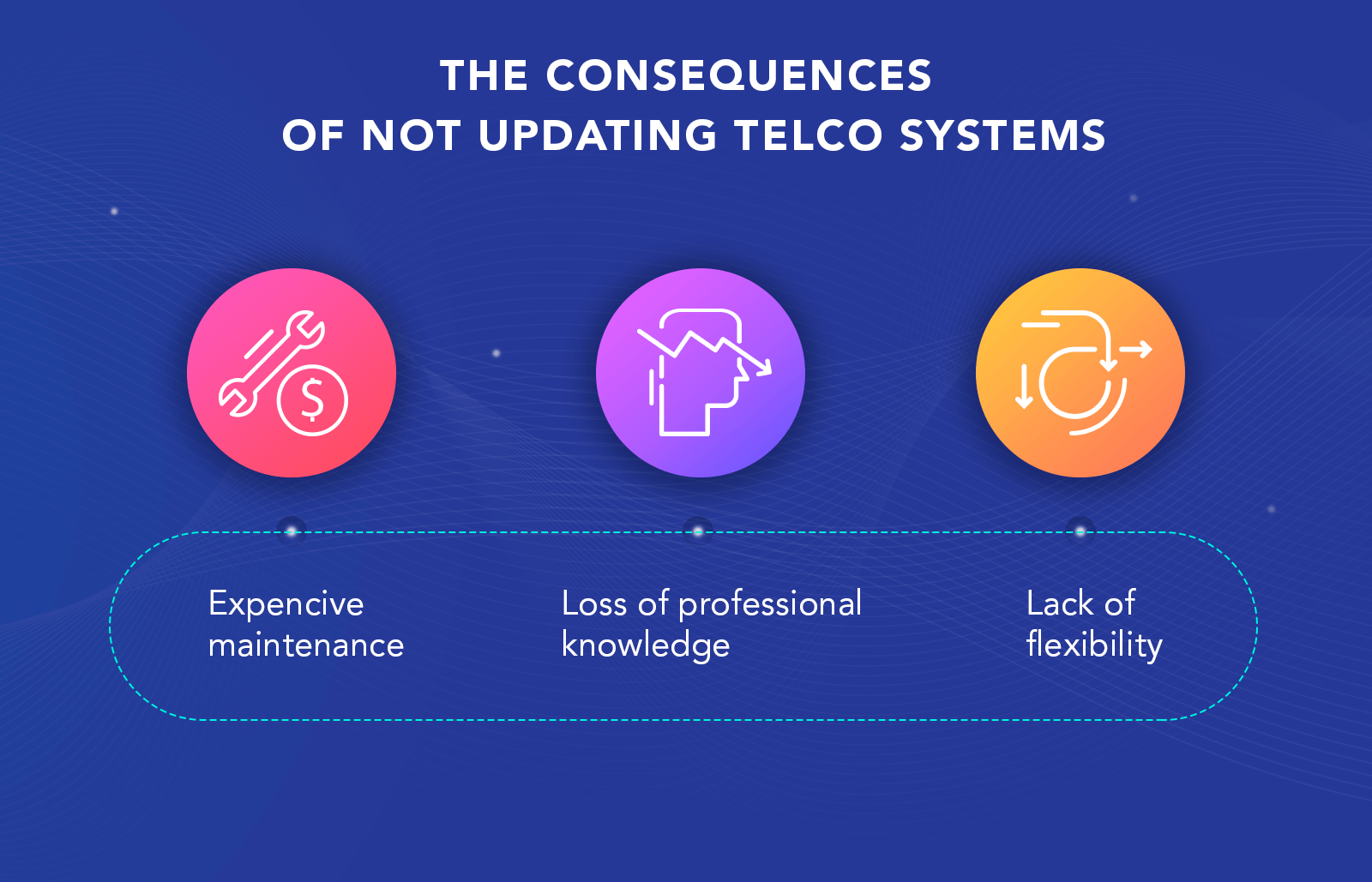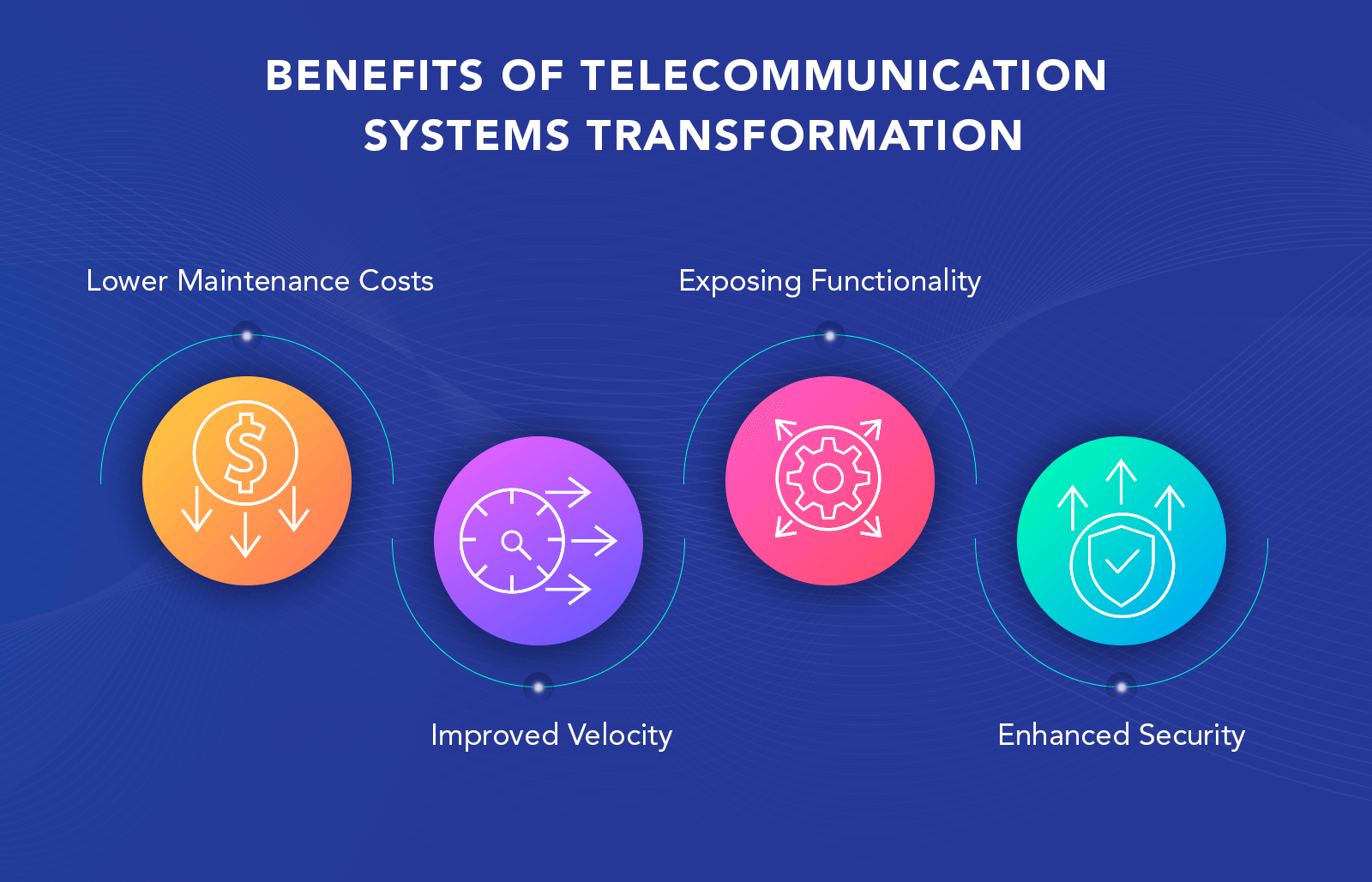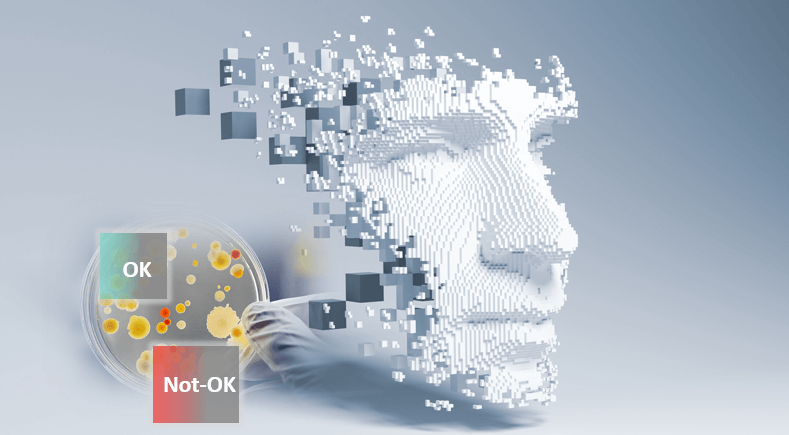Dell states in its paper that during the last 10 years, a rough amount of all applications used by Fortune 5000 companies “run in legacy environments built 20, 30, even 40 years ago.” Also, Dell claims that “a typical corporation spends between 60 and 80 percent of its IT budget simply to maintain existing mainframe systems and applications.”
Why the Telco Industry?
As we discussed in our previous article, the telecommunication industry is experiencing economic and high pressure from constantly growing market demands. With millions of subscribers and a growing number of telco products, today’s communication service providers (CSPs) must manage their business more efficiently than ever before, constantly optimizing services, networks, and products. Many CSPs continue to use systems and applications that are often too complex and inefficient for their business needs. What are the legacy systems?
What Are Legacy Systems
Legacy systems are outdated systems and applications that can no longer support business objectives, as they apply archaic methods that cannot perform tasks in fast-growing companies. Unmodified legacy systems pose the key challenge on the way to digital infrastructure. Because of its outdated architecture, such systems are usually very difficult and expensive to maintain, support, and integrate with the new digital environment.
Why is Legacy System Modernization so Important?
Legacy systems are highly monolithic. On the one hand, they are very complex to manage and difficult to update. On the other hand, they are expensive to scale.
Besides, Legacy Systems hinder the ability to address the internal and external needs of customers. Of course, such systems can still operate relatively well, but there will always be some limitations. Be it poor security or low performance, CSPs will be affected significantly without the user even noticing it.
According to a Deloitte report on legacy systems and their modernization:
“Legacy solutions lack flexibility and carry a significant technology debt due to dated languages, databases, architectures, and a limited supply of aging baby-boomer programmers. This liability prevents many organizations from advancing and supporting analytics, real-time transactions, and a digital experience.“
For legacy systems to obtain needed flexibility and agility in a way that aligns with modern business demands, it is possible to get them modernized. Another incentive for legacy systems modernization is high maintenance costs. “The older the IT system is, the more difficult and expensive it is to maintain.” – claims our expert, Head of Telco Yaroslav Skrypnyk.
With time the technologies used for the creation of legacy systems become outdated, and professionals stop working with them. As a result, it becomes harder and harder for companies that operate on legacy systems and applications to recruit experts who can maintain and support such systems.
Why Legacy Systems Should Be Upgraded
The answer is evident – it is high costs, poor performance, and, as a result, low efficiency. Telco providers using legacy systems will inevitably face increased operational risks due to unsupported hardware and software, resulting in significant losses for CSPs. Compared with the modernization of legacy systems, completely removing and replacing the outdated system with a new one is certainly less cost-effective and more time-consuming.

The Process of Modernization
There are different levels of complexity of system modernization depending on the current state of a legacy application. Some legacy systems may require remediation, others – re-platforming or migrating to a new standards-based ecosystem.
The process of legacy systems modernization includes three stages. First, it is necessary to assess the current state of code and legacy requirements and work out a development roadmap for renewing the outdated system. The second stage is called reengineering, which focuses on the extraction of business requirements from legacy software and recasts them in natural language for further analysis and forward engineering. The last stage is migration and modernization. At this point, the development team modernizes the platform infrastructure, its internal architecture and adds desired features.
Artificial Intelligence for Legacy System Modernization
The assessment process of legacy systems can be very challenging. If an application is outdated, and the people who developed it are no longer accessible, or the knowledge of the applied programming language is missing, then Artificial Intelligence (AI) with its Machine Learning capabilities comes to the rescue.
Such applications as SonarQube, which largely rely on AI and ML power, help developers to analyze codes, even if the latter is using outdated frameworks, and identify bugs, useless parts of the code as well as security vulnerabilities.

Benefits of Telco Legacy System Modernization
- LOWER MAINTENANCE COSTS
Outdated applications require continual support, which results in high operating expenses. Modernization of legacy applications makes them operate with greater efficiency and without constantly occurring errors that must be fixed manually. The result is considerable cost savings.
- IMPROVED VELOCITY
Using new technological stacks in legacy systems modernization processes allows developers to empower updated applications with greater velocity. Such technologies as AI, ML, Mobile apps, the Internet of Things, and Managed Code can enhance existing obsolete applications, making them faster and more efficient.
- EXPANDING THE FUNCTIONALITY
Modernization is not only about streamlining performances. It is also about adding new features. As the tech world is evolving at a rapid pace, users have become more and more sophisticated. New innovative elements implemented into existing applications can better position companies to meet users’ desires and requirements.
- ENHANCED SECURITY
“A switching to a more recent and advanced technology stack automatically excludes any problems with vulnerable security,” says Yaroslav Skrypnyk, Head of Telco Department at Softengi.
Most old systems have significant flaws in terms of security, as in the past, cases of data breaches and digital frauds were a rarity. Contrarily, the latest technologies consider security and data protection as primary goals.
How Softengi May Help?
Softengi, with its five-year experience in the Telco industry, helps CSPs to plan and implement modernization initiatives aligned with clients’ needs and requirements. Using cutting-edge methodologies and techniques, Softengi assembles collaborative teams with state-of-the-art innovative tools to reach better flexibility and agility of legacy systems with minimal disruptions to operations.




